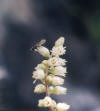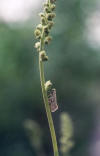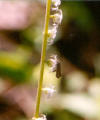Greya moths and Host Plants
Department of Biological Sciences
![]()
While incoming students are completely free to choose a study system of their own, the opportunity also exists to utilize the well developed interactions between moths of the genus Greya and their host plants in the Saxifragaceae. Much of the appeal to using this system is that students can build upon existing work to ask conceptually novel questions without the downtime required to develop new study systems. In addition, these interactions are now developed to the point that they are one of the best available systems for asking questions regarding the impact of plant polyploidy on insect diversification, the role of spatial structuring in coevolutionary dynamics, the evolution of mutualism, or ecological speciation.
Some of the more common local Greya moths and their host plants are described below. For a broader geographic and taxonomic perspective on Greya moths and their relatives the Yucca moths check out the Prodoxidae on the Tree of Life. For more details on the Yucca moths themselves, head on over to Olle Pellmyr's web page here at the University of Idaho.
This moth oviposits into the flowers of its host plants (photo at left), where its larvae develop and feed on plant seeds. This moth is also an effective of pollinator of one of its host plants, making it an excellent system for studying the evolution of mutualism. In northern Idaho G. politella uses two different host plants: Lithophragma parviflorum, and Heuchera grossulariifolia. Populations that use H. grossulariifolia use diploids within some regions but tetraploids or a mixture of both ploidies in others.

Greya politella ovipositing into tetraploid H. grossulariifolia
In contrast to G. politella, G. piperella oviposits into the flowering scapes of its host plants (photo at left). Larvae then feed and develop within the flowering scape. In northern Idaho G. piperella uses two different host plants: H. grossulariifolia and H. cylindrica. As with G. politella G. piperella uses both diploid and tetraploid H. grossulariifolia.

Greya piperella ovipositing into diploid H. grossulariifolia
Very closely related to G. politella and has a similar life cycle, ovipositing into the flowers of its host plant where the larvae develop and feed on seeds. In northern Idaho G. enchrysa uses H. cylindrica as a host plant.
Greya enchrysa on Heuchera cylindrica
Greya mitellae:
This moth is very similar to G. piperella in appearance and life cycle. Adult females oviposit into the flowering scapes of the host plant where the larvae feed and develop. In northern Idaho G. mitellae uses Mitella stauropetala as its host plant. Unlike the other Greya species on this age, G. mitellae is generally found in shaded understory.

Greya mitellae nectaring on Mitella stauropetala